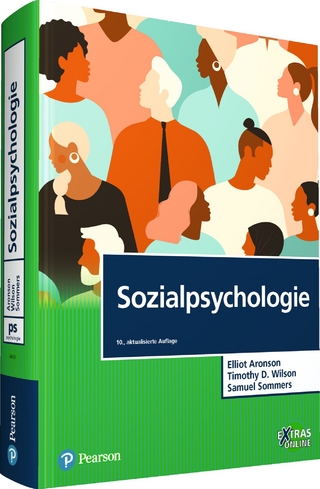
Health and Behavior
Rowman & Littlefield (Verlag)
978-1-4422-7406-8 (ISBN)
Health and Behavior: A Multidisciplinary Approach recognizes that health is impacted by multiple systems–ranging from the individual to the international. While providing current information in common areas addressed in health psychology such as stress, chronic pain, cigarette smoking and sleep disorders, the book examines cross-cultural dimensions in wellness and health care as well as health communication ranging from clinician and patient to the social marketing models used in public health. The book departs from traditional health psychology and health behavior textbook with its attention to public policy and international dimensions of health care. Topics include an international comparison of health care systems, a history of health care funding in the United States including the Affordable Care Act, the role of Federal Social Security Disability policy in chronic pain management, international medical tourism, and health care disparities in the United States. Each chapter begins with a “conversation” with the author relating the topic to real world problems as well as the student’s life experience.
H. Russell Searight is currently Professor of Psychology at Lake Superior State University in Sault Sainte Marie, Michigan. He received his PhD in Clinical Psychology from Saint Louis University and later received a Master’s in Public Health from the Saint Louis University School of Public Health. Dr. Searight was involved in medical education for eighteen years as a faculty member in a family medicine residency as well as at Saint Louis University School of Medicine. He has published widely in the areas of medical ethics; primary care medicine, and cross-cultural issues in health care.
Preface: A Personal Introduction
Chapter 1. Introduction to Health and Behavior: A Systems Perspective
Illness versus Disease
The Concept of Diathesis
Diathesis-Stress Models Explain Interaction Between Biological and Psychological Predispositions and the Emergence of Illness
Health and Illness Occur in Complex Systems
Von Bertalanffy’s Systems Perspective
Brofenbrenner’s Ecosystems
The Biopsychosocial Model
Examples of Health and Illness and Levels of Complex Systems
Individual Level
DNA
Communication Between Organ Systems: The Brain-Gut Connection
Psychopathology and Health: The Rise and Fall of Psychosomatic Medicine
Interpersonal Systems: Couples and Families
The MesoSystem—Cultural Values and Religion
Macrosystems
Communities
Changes in National Politics and Economics
Beyond Macrosystems: Our Flat World—International Borders Dissolve
Putting It Together: Ms. Ramirez
Summary and the Way Forward
Chapter 2. Research in Health and Behavior: Epidemiology and Beyond
Epidemiology: An Overview
Food-Borne Illness: Two Examples
Example: Sexually Transmitted Disease
Epidemiology: Key Concepts and Terminology
Risk Factors and the Diathesis-Stress Model
Practical vs. Statistical Significance: Prevalance, Base Rates, and Health Screening Tests
Neurocognitive Disorders of Alzheimer’s Type
Screening for Breast Cancer
HIV Self-Testing
Autism Spectrum Disorder
Epidemiology: Types of Investigatory Designs
Case Reports
Cross-Sectional Studies
Case-Control Studies
The “Radium Girls”
Thalidomide
Mesothelioma and Asbestos
Cohort Study
The Framingham Heart Study
Cancer and Nutrition: The EPIC Cohort
Qualitative Research
Social Epidemiology
Causality and the Bradford Hill Criteria
Evidence-Based Health Care
Organizing Published Research to Guide Clinical Decision-Making
Issues and Cautions in Applying EBM Findings
Evidence-Based Interventions in Larger Systems
Conclusion
Chapter 3. The Health Care System: History and Current Dilemmas
A History of Medical Care
Hippocrates and Galen
Medieval Period Through the Late 1600s
Hospital Medicine
Vaccines
Germ Theory and the Continued Development of Vaccines
Surgery Becomes Safer
Educating Physicians
The Development of Medicine as a Profession
The Growth of Scientific Medicine
Imaging Techniques
Medical Devices to Supplant Physiological Functions
Organ Transplantation
Medications
The Consumer Movement and Challenges to the Health Care Professions
Health Insurance and Health Care
Federal Health Insurance: Medicare and Medicaid
Medicare
Medicaid
S-CHIP
The Uninsured
The Emergency Treatment and Active Labor Act
Health Care Reform: The Background of the Affordable Care Act
The Affordable Care Act
Problems with the Affordable Care Act
The U.S. Health Care System: International Comparisons
Switzerland
Great Britain
Canada
International Health Care: Differences in Underlying Values
Conclusion
Chapter 4. Diversity and Disparities in Health and Medical Care
Disparities: An Overview
Economic Disparity
Educational Disparities and Health
Gender
Gender in Developed Countries
Gender in Developing Countries
Sexual Orientation
Mental Health
Interactions with the Health Care System
Transgender and Gender Non-Conforming Youth and Adults
Disparities by Race/Ethnicity: The Evidence
Pregnancy and Infancy
Childhood Health Conditions
Medical Conditions Disproportionately Impacting Minorities
Differences in Health Conditions Among Adults
Discrimination Towards African-American Patients
Risk Factors and Disease Complications
Patterns and Quality of Care
Physician-Patient Interaction
Mortality
Linguistic Diversity
The Role of Cultural and Historical Factors in Health, Illness, and Treatment
American Medicine as Culture
A Brief History of Health Care for African-Americans in the United States
Hispanic and Latino Culture and Health Care
Asian Culture: Views of Health and Treatment of Illness
Conclusion
Chapter 5. Health Communication and Behavior Change
Brief Overview of Health Communication and Behavior Change
Health Beliefs Model
Susceptibility
Severity
Benefits
Barriers
Cues to Action
Self-Efficacy
Analysis of the Health Beliefs Model
Does Fear Change Health Behavior?
Theory of Reasoned Action and Theory of Planned Behavior
Behavioral Intention
Attitudes
Subjective Norms
Perceived Control
Theory of Reasoned Action and Theory of Planned Behavior: Analysis and Research
Social Cognitive Model
Example of Applied Modeling: Telenovelas
Social Marketing
Diffusion of Innovation
Individually Focused Models of Behavior Change
Transtheoretical Model
Relapse Prevention
Relapse Risk Factors
Abstinence Violation Effect
Problems with the Abstinence Standard
Relapse Prevention Strategies
Motivational Interviewing
Philosophy of Motivational Interviewing
Motivational Interviewing: Specific Skills
Harm Reduction
Cyber Media and Health Behavior Change
Conclusion
Chapter 6. In the Clinic: Communication, Adherence, and Symptoms without Disease
What is Primary Care ?
The Importance of the Clinical Interview
Overview of the Medical Office Encounter
The Difference between Good- and Poor-Quality Physician-Patient Interaction
Electronic Medical Records: Benefits and Drawbacks
Values of Patients and Health Care Providers
Communicating Medical Mistakes
Medically Unexplained Symptoms
The Psychiatric Approach to Medically Unexplained Symptoms
Malingering
Factitious Disorder
Conversion Disorder
Illness Anxiety Disorder
Somatic Symptom Disorder
Medically Unexplained Symptoms in the Primary Care Office
Cultural Issues
The Medicalization of Society
Adherence
An Overview of the Problem of Non-Adherence
Patient Factors
Health Care Professionals’ Communication Style and Patient Adherence
Physician Social Power and Adherence
Timing and Modality
Does Fear Increase Adherence
Characteristics of the Illness and Treatment
Social Support
Interventions for Increasing Adherence
Mobile “Apps” for Adherence
Adherence as the Result of a Complex Biopsychosocial Decision
The Macro System’s Role in Adherence
A Vaccination Program Arouses Suspicion
Making Health a Requirement for Employment
Economic Causes of Non-Adherence
Conclusion
Chapter 7. Stress and Coping
What is Stress ?
Walter Cannon and the Fight-or-Flight Response
Hans Selye and the General Adaptation Syndrome
Allostatic Load
Psychoneuroimmunology
Tend and Befriend
Transactional Model
Assessing Stress
Perceived Stress Scale
Social Readjustment Rating Scale
Hassles and Uplifts
Mediators and Moderators of Stress
Characteristics of the Stressor
Emotional State
Coping Styles
History of Exposure to Stressors
Personality Traits
Does Stress Cause Physical Illness ?
Cardiovascular Disease, The Type A Personality, and Depression
Cardiovascular Disease and Anxiety and Depression
Hypertension
Cancer
The Macro System
Environmental Factors
Couples and Relationship Conflict
Workplace
Community
Social and Economic Costs of Early Traumatic Experience
Diversity
Gender
Stress Across Cultures
Specific Strategies for Stress Reduction
Progressive Relaxation
Autogenic Training
Biofeedback
Meditation
Transcendental Meditation
Benson’s Relaxation Response
Mindfulness Meditation
Cognitive Intervention
Acceptance and Commitment Therapy
Journaling: Writing to Manage Stress
Positive Psychology
Background
Positive Psychology Interventions
Conclusion
Chapter 8. Chronic Pain as a Psychosocial Condition: Causes, Consequences, and Treatment
Pain Defined
When does Pain Become Chronic ?
Chronic Pain-A Brief History
Common Pain-Related Disorders
Fibromyalgia
Low Back Pain
Headache
Cancer
Explanations of Chronic Pain
Operant Model
Cognitive Perspectives
Gate Control Model
Neuromatrix Model
Pain as a Social Metaphor
Pain and the Workplace
Cross-Cultural Aspects of Pain
The Macro System: The Politics of Chronic Pain and its Treatment
Pain, the Work Ethic, and the Politics of Disability
The Politics of Gate Control Theory
Intractable Pain and Physician-Assisted Suicide
Pain as a Fifth Vital Sign and the Rise of Opiates
Assessment of Pain
Rating Scales
Pain Diary
The Clinical Interview for Pain
Chronic Pain: Treatment Approaches
Surgery
Implantable Spinal Stimulators
Medications
Trans-Electrical Nerve Stimulation (TENS)
Acupuncture
Physical Therapy
Behavioral and Psychological Approaches
Behavioral Approaches to Treatment
Progressive Relaxation Training
Biofeedback
Hypnosis
Cognitive Behavioral Therapy
Third Wave Cognitive-Behavioral Therapy
Multidisciplinary Pain Programs
Conclusion
Chapter 9. Smoking and Smoking Cessation
Health Risks of Smoking and Tobacco Use
History of Cigarette Smoking
Demographics of Smoking
Smoking Initiation
Mental Health Conditions and Smoking
The Macro-System: Public Health, The Tobacco Industry, and Tobacco Control Policies
Tobacco Taxes and Related Legislation
Public Education
Smoking Ban
The Tobacco Industry
Mental Illness and Tobacco Use
Ethnicity, Culture, and Smoking
Smoking Cessation—Common Issues
Background for Smoking Cessation
Assessment
Nicotine Withdrawal
Interventions
Pharmacotherapy
Cognitive and Behavioral Strategies
Stages and Successful Smoking Cessation Strategies
Preparation
Action
Vaping and e-Cigarettes
Conclusion
Chapter 10. Obesity, Exercise, and Eating Disorders
Obesity’s Role in Health and Illness
Risk Factors for Being Overweight
Body Weight, Stereotypes, and Discrimination
Weight Loss Interventions
Low Calorie Diets
Behavioral and Cognitive Behavioral Approaches
Weight Loss Medication
Bariatric Surgery
The Macro System
Cultural Factors in Food Consumption: The French Paradox
The Food Industry
Policies for Increasing Nutritional Awareness
Sugar Taxes
Marketing and Economic Factors
Exercise
A Brief Historical Perspective
Exercise and Mental Health
Exercise and Cognitive Functioning
Developmental Benefits of Exercise for Prevention of Mental Health Conditions
Macro Systems and Physical Activity
Eating Disorders
Anorexia Nervosa
Physical and Medical Effects
Comorbid Conditions
Course over Time
Causes
Treatment
Bulimia Nervosa
Psychological and Physical Effects
Comorbid Conditions
Course over Time
Causes
Treatment
Binge Eating Disorder
Eating Disorders: Immediate Social and Macro System Influences
Family and Social Factors
Mass Media
Cross Cultural Studies of Eating Disorders
Eating Disordered Culture
Conclusion
Chapter 11. Sleep and Sleep Disorders
Why do we Sleep ?
The Stages of Sleep
Non-REM Stages
Stage 1
Stage 2
Stage 3
Stage 4
REM Sleep
Circadian Rhythm
Sleep Through the Lifespan
Reasons for Disrupted Sleep
The Macro System: Diversity and Sleep
Culture
Gender
Ethnicity
The Cross-Cultural Significance of Sleep Paralysis
Sleep Disorders
Insomnia
Definition and Prevalence
Health Conditions Associated with Insomnia
Medications Causing Insomnia
Psychological Causes of Insomnia
Insomnia Treatment
Obstructive Sleep Apnea
Narcolepsy
Restless Legs Syndrome
Excessive Daytime Sleepiness
Hypersomnia
Childhood Sleep Disorders
Bedtime Refusal
Sleep (Night) Terrors
Nightmare Disorder
Somnambulism (Sleep Walking)
Conclusion
Chapter 12. Psychosexual Disorders
The Sexual Response Cycle
Erectile Dysfunction
Female Sexual Interest/Arousal Disorder
Problems with Ejaculation
Premature (Early) Ejaculation
Delayed Ejaculation
Female Orgasmic Disorder
Genito-Pelvic Pain Penetration Disorder
Cross-Cultural Issues in Sexuality
Conclusion
Chapter 13. The Future Direction of Health and Health Care
The Interface of Physical and Mental Health
Collaborative and Integrated Care
Increased Attention to the Psychosocial in Medical Care
Psychosocial “Vital Signs”
Brief Models of Counseling for Busy Physicians
Professionalism and Patient Centered Care
Health Care Navigators
Internationalization: The Flat Word Continues to Flatten
The Aging Population and the Maximization of Life
Conclusion
References
Index
| Erscheinungsdatum | 15.03.2019 |
|---|---|
| Verlagsort | Lanham, MD |
| Sprache | englisch |
| Maße | 181 x 259 mm |
| Gewicht | 744 g |
| Themenwelt | Geisteswissenschaften ► Psychologie ► Sozialpsychologie |
| ISBN-10 | 1-4422-7406-9 / 1442274069 |
| ISBN-13 | 978-1-4422-7406-8 / 9781442274068 |
| Zustand | Neuware |
| Haben Sie eine Frage zum Produkt? |
aus dem Bereich


